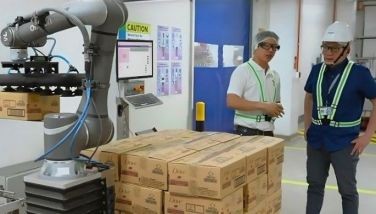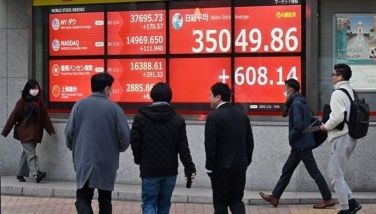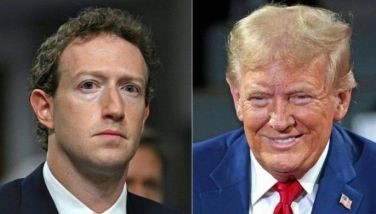We’re still Asia’s laggard

May 12, 2006 | 12:00am
The stock market may be at a record high and the fiscal situation now seems under control, but there is still a lot of work ahead of us before politicians can start dancing the cha-cha and playing their crazy games. According to the International Monetary Fund (IMF), the Asian region is expected to grow by seven percent this year despite threats such as rising oil prices, tighter global financial conditions, and current account risks.
The economic forecast for the Philippines, however, was much lower at five percent, broadly in line with earlier projections by other multilateral institutions. The World Bank, in its East Asia Outlook, saw Philippine growth at 5.3 percent, while the Asian Development Bank estimates our growth at five percent, citing uncertainties in farm output. We need to grow at least seven percent for a number of years in order to make a dent on our poverty rate.
Our problem, the IMF said, is our continued reliance on foreign borrowings, even as they acknowledged the improvement in our country’s macroeconomic fundamentals. In fact, we are meeting our fiscal targets so that the National Treasurer can now afford to reject bids in the weekly auction of Treasury bills. Still, we are Asia’s largest foreign borrower, and we cannot afford to relax on our target to trim down our fiscal deficit.
Questions have also been raised on the sustainability of our so called strong peso. For one, our export sector seems anemic this year. Economists find the decline early this year ominous, as it showed the sector has not recovered from its disappointing performance last year. The double-digit growth in December, economists say, may just be seasonal.
Economists are worried exports may not really recover amid lingering concerns about high oil prices, rising interest rates and a stronger peso. However, there is good news. Overall exports in the first quarter caught up somehow, and moved up 13.8 percent from a year ago. But that’s largely electronics and garments… making us very vulnerable to the volatile conditions in the world market.
As we said about the exchange rate, it is also wrong to think that a stock market boom is necessarily a good measure of economic health. The stock market benefits largely foreign players and a few locals and the common Pinoy is hardly affected. While the uptick in the bourse may indicate some level of foreign investor confidence, we must remember that we are dealing with "hot money" which can just as easily evaporate. Rather than real confidence in our economy, "hot money" may be here only because some gutsy foreign money managers found themselves too liquid and we look like a nice momentary bet.
Let us also remember that directly-measured high levels of economic deprivation has demonstrated yet again, SWS points out, that even orthodox economic statistics such as gross national product give a very misleading picture of the state of economic well-being. There are still too many Filipinos going hungry out there.
SWS’s survey showed an estimated 2.8 million families or 16.7 percent of the population reported having nothing to eat at least once from October to December last year. Self-Rated Poverty also rose to 57 percent from 49 percent in the third quarter of 2005. The hunger proportion has been in double-digits ever since the second quarter of 2004, raising the 1998-2005 average hunger to 10.6 percent. It was last recorded at 15.5 percent in August 2005.
There is a lot to do yet before our politicians can cha-cha. But how do we get them to focus on things they should be doing? I am afraid we will always be the laggards among the tiger economies of the region… thanks to our politicians and the voters who elect them.
Dr. Ernie E. sent me something that’s no laughing matter about the marketing practices of big drug companies. In the light of that scandalous unethical drug testing in Nigeria and our own problems trying to make life saving drugs affordable, I thought the article written by Marcia Angell, MD of the Department of Social Medicine of Harvard Medical School is very timely.
Here are some interesting portions of that article.
Claim: The increased costs of drugs reflect large investments in research and development (R&D).
Fact: Drug companies spend more than twice as much on "marketing and administration" as they do on R&D – 31 percent of sales, compared with 14 percent in 2003. Drug industry sources say the R&D cost per drug is $800 million, on average. An independent analysis by the non-profit consumer advocacy organization Public Citizen shows that the real cost is probably $100 million or less.
Actually, the big drug companies don’t develop most of the novel medications. These drugs, such as the cancer medications paclitaxel (Taxol) and imatinib (Gleevec), mostly are the result of taxpayer-funded research at academic institutions or the National Institutes of Health (NIH) or research at small biotechnology companies.
Claim: New drugs are constantly being brought to market.
Fact: Of the 487 drugs approved by the FDA from 1998 through 2003, only 32 percent contained new active ingredients and fewer than half of those (14 percent of the total) were classified by the FDA as improvements over older drugs.
Most "new" drugs are chemical variations of older drugs already on the market – so-called "me-too" drugs. Companies try to grab a piece of a profitable market by producing a medication similar to a top-selling drug.
Example: Mevacor, approved in 1987, was the first cholesterol-lowering statin in the marketplace. Now, there are five more, all variants of the original – Lipitor, Zocor, Pravachol, Lescol and Crestor. Even though Lipitor and Zocor are the top-selling statins, no head-to-head studies have been conducted comparing their effectiveness with lovastatin (the cheaper generic form of Mevacor) when taken at equivalent doses.
Claim: Doctors’ prescribing habits aren’t unduly influenced by drug companies.
Fact: In 2001 the drug industry employed approximately 88,000 sales representatives to visit doctors in their offices and hospitals to promote their products – roughly one representative for every six practising physicians.
In 2001, drug companies paid more than 60 percent of the costs for continuing medical education for doctors. Meetings of professional societies, such as the American College of Cardiology and the American College of Physicians, now are largely sponsored by drug companies.
I guess the situation in the Philippines isn’t that different. The prescribing habits of our doctors aren’t based only on objective evaluations of their patients. As in America, unethical marketing practices of drug companies have a strong influence here too.
Here’s an e-mail from an overseas Pinoy, reacting to a previous column on the pre-need firms.
What’s disappointing with decent society is not only how they accept the people behind the pre need crisis as their own. Some of their highly-regarded institutions have also heaped praises on some of the pre-need company owners after receiving donations from them despite the reality that these owners have not been able to fulfill their financial obligations to their policy holders.
Observe how La Salle, the University of San Francisco and Columbia University have honored Ambassador Yuchengco for his various "generous endowments" to these institutions and have included him in their affiliates’ boards of trustees. I wonder if it occurred to these institutions how the ambassador could afford to shower them with cash when so many ordinary Filipinos are waiting for his company to keep its promises in exchange for taking a portion of their hard-earned savings.
It only proves that in a capitalist society, decency and good reputations can sometimes be bought and intangible standards can be compromised.
A reader who calls himself "kuya betong" sent this classic.
While a man and his ever-nagging wife were visiting Jerusalem, the wife died. The undertaker asked the husband whether he would like her body shipped home for $5,000 or buried in the Holy Land for $500.
The husband chose to ship her home. The undertaker asked, "why spend so much money when it would be cheap and wonderful to bury her in the Holy Land?"
The husband replied, "long ago, a man was buried here and after three days he rose again, I can’t take that chance!"
Boo Chanco’s e-mail address is [email protected]
The economic forecast for the Philippines, however, was much lower at five percent, broadly in line with earlier projections by other multilateral institutions. The World Bank, in its East Asia Outlook, saw Philippine growth at 5.3 percent, while the Asian Development Bank estimates our growth at five percent, citing uncertainties in farm output. We need to grow at least seven percent for a number of years in order to make a dent on our poverty rate.
Our problem, the IMF said, is our continued reliance on foreign borrowings, even as they acknowledged the improvement in our country’s macroeconomic fundamentals. In fact, we are meeting our fiscal targets so that the National Treasurer can now afford to reject bids in the weekly auction of Treasury bills. Still, we are Asia’s largest foreign borrower, and we cannot afford to relax on our target to trim down our fiscal deficit.
Questions have also been raised on the sustainability of our so called strong peso. For one, our export sector seems anemic this year. Economists find the decline early this year ominous, as it showed the sector has not recovered from its disappointing performance last year. The double-digit growth in December, economists say, may just be seasonal.
Economists are worried exports may not really recover amid lingering concerns about high oil prices, rising interest rates and a stronger peso. However, there is good news. Overall exports in the first quarter caught up somehow, and moved up 13.8 percent from a year ago. But that’s largely electronics and garments… making us very vulnerable to the volatile conditions in the world market.
As we said about the exchange rate, it is also wrong to think that a stock market boom is necessarily a good measure of economic health. The stock market benefits largely foreign players and a few locals and the common Pinoy is hardly affected. While the uptick in the bourse may indicate some level of foreign investor confidence, we must remember that we are dealing with "hot money" which can just as easily evaporate. Rather than real confidence in our economy, "hot money" may be here only because some gutsy foreign money managers found themselves too liquid and we look like a nice momentary bet.
Let us also remember that directly-measured high levels of economic deprivation has demonstrated yet again, SWS points out, that even orthodox economic statistics such as gross national product give a very misleading picture of the state of economic well-being. There are still too many Filipinos going hungry out there.
SWS’s survey showed an estimated 2.8 million families or 16.7 percent of the population reported having nothing to eat at least once from October to December last year. Self-Rated Poverty also rose to 57 percent from 49 percent in the third quarter of 2005. The hunger proportion has been in double-digits ever since the second quarter of 2004, raising the 1998-2005 average hunger to 10.6 percent. It was last recorded at 15.5 percent in August 2005.
There is a lot to do yet before our politicians can cha-cha. But how do we get them to focus on things they should be doing? I am afraid we will always be the laggards among the tiger economies of the region… thanks to our politicians and the voters who elect them.
Here are some interesting portions of that article.
Claim: The increased costs of drugs reflect large investments in research and development (R&D).
Fact: Drug companies spend more than twice as much on "marketing and administration" as they do on R&D – 31 percent of sales, compared with 14 percent in 2003. Drug industry sources say the R&D cost per drug is $800 million, on average. An independent analysis by the non-profit consumer advocacy organization Public Citizen shows that the real cost is probably $100 million or less.
Actually, the big drug companies don’t develop most of the novel medications. These drugs, such as the cancer medications paclitaxel (Taxol) and imatinib (Gleevec), mostly are the result of taxpayer-funded research at academic institutions or the National Institutes of Health (NIH) or research at small biotechnology companies.
Claim: New drugs are constantly being brought to market.
Fact: Of the 487 drugs approved by the FDA from 1998 through 2003, only 32 percent contained new active ingredients and fewer than half of those (14 percent of the total) were classified by the FDA as improvements over older drugs.
Most "new" drugs are chemical variations of older drugs already on the market – so-called "me-too" drugs. Companies try to grab a piece of a profitable market by producing a medication similar to a top-selling drug.
Example: Mevacor, approved in 1987, was the first cholesterol-lowering statin in the marketplace. Now, there are five more, all variants of the original – Lipitor, Zocor, Pravachol, Lescol and Crestor. Even though Lipitor and Zocor are the top-selling statins, no head-to-head studies have been conducted comparing their effectiveness with lovastatin (the cheaper generic form of Mevacor) when taken at equivalent doses.
Claim: Doctors’ prescribing habits aren’t unduly influenced by drug companies.
Fact: In 2001 the drug industry employed approximately 88,000 sales representatives to visit doctors in their offices and hospitals to promote their products – roughly one representative for every six practising physicians.
In 2001, drug companies paid more than 60 percent of the costs for continuing medical education for doctors. Meetings of professional societies, such as the American College of Cardiology and the American College of Physicians, now are largely sponsored by drug companies.
I guess the situation in the Philippines isn’t that different. The prescribing habits of our doctors aren’t based only on objective evaluations of their patients. As in America, unethical marketing practices of drug companies have a strong influence here too.
What’s disappointing with decent society is not only how they accept the people behind the pre need crisis as their own. Some of their highly-regarded institutions have also heaped praises on some of the pre-need company owners after receiving donations from them despite the reality that these owners have not been able to fulfill their financial obligations to their policy holders.
Observe how La Salle, the University of San Francisco and Columbia University have honored Ambassador Yuchengco for his various "generous endowments" to these institutions and have included him in their affiliates’ boards of trustees. I wonder if it occurred to these institutions how the ambassador could afford to shower them with cash when so many ordinary Filipinos are waiting for his company to keep its promises in exchange for taking a portion of their hard-earned savings.
It only proves that in a capitalist society, decency and good reputations can sometimes be bought and intangible standards can be compromised.
While a man and his ever-nagging wife were visiting Jerusalem, the wife died. The undertaker asked the husband whether he would like her body shipped home for $5,000 or buried in the Holy Land for $500.
The husband chose to ship her home. The undertaker asked, "why spend so much money when it would be cheap and wonderful to bury her in the Holy Land?"
The husband replied, "long ago, a man was buried here and after three days he rose again, I can’t take that chance!"
Boo Chanco’s e-mail address is [email protected]
BrandSpace Articles
<
>
- Latest
- Trending
Trending
Latest
Recommended



























